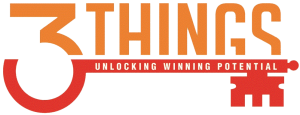While the fundamentals of pursuing, pitching, and winning business don’t change in the virtual world, there is a lot more opportunity to get it wrong and blow the deal. Most of this comes back to a key principle a former business partner of mine held near and dear – “The pitch is a proxy for what you’re going to be like to do business with“. All of the research and buyer interviews I’ve done over the last 15 years point to the fact that customers are looking for suppliers who understand their situation, pitch as ‘one team’, and demonstrate they’ve got their act together. They want to see suppliers are responsive, organised, prepared, and on-the-ball at every stage of the sale. Every interaction can be make or break – particularly when pitching for major deals, bids and tenders.
All of this makes the virtual sales, pursuit and pitch process highly problematic. While some salespeople get by ‘winging it’ in person, the margin for error is significantly reduced when most or all or the interactions are done online. As one GM of Sales said to me last week; “Some of them are pretty hopeless when it comes to organizing and running a standard meeting with a client on Zoom, how the hell are they going to pitch and win a complex deal?”
In the last extensive research we conducted with buyers, almost 26% of their decision not to buy from a salesperson was based on a lack of ‘professional discipline’ and organization. They assessed salespeople pretty ruthlessly in terms of how well they had prepared for meetings (16% of their decision), and how well they followed up (10%). Both factors were critical to the buyers perception of what a salesperson would be like to work with, and how likely they were to give them their business. Based on this, it is essential sales professionals apply three ‘F’s when planning and executing virtual sales interactions:
Fail-safes – STOP trusting in technology (too much). While it’s a handy tool and one we rely on – particularly at the moment – it’s not always your friend. Think back to the last time you attended a webinar, virtual meeting, sales or information session where the technology didn’t really work or the host seemed mildly or grossly incompetent at operating it. Did you feel more annoyed with the technology, or with the host? Did it in some way take the shine off their content or the point of their session? Unfortunately customers judge us on the experience and outcomes we deliver, not our intentions or best-laid plans. Two key focus areas required to mitigate this risk:
- Use the right technology. Years ago, one of my mentors reinforced in me the mantra; ‘Check the technology!’, and it’s stuck with me ever since. While bad outcomes are easy to dismiss as “it wasn’t me, it was the technology that failed“, most customers don’t see it that way. Sales professionals need to hope for the best, but plan for the worst. Use the simplest, proven technology that delivers the impact you want – the pitch is not the time to experiment. Have fail-safes built in to every interaction – multiple log-in options (phone and video) with details easy to access, agendas and copies of the presentation sent before the session (with page numbers to talk them through if required), and NEVER do a live demo unless you absolutely need to – instead do a screen recording of an interactive demo with a voice-over or talking head alongside it. Ensure everyone on your team knows how to use and trouble-shoot the technology because it can and probably will, according to Murphy; “go wrong, and at the worst possible time“.
- Use the technology right. From a technical point of view, always test the hardware, software, and bandwidth of everyone on the presentation team and on the customer side (whenever possible). Do this well ahead of major meetings and pitches and do test-runs with the customer to make sure they can run it well on their end to ensure there’s minimal friction and annoyance caused by poor quality audio and video. Encourage everyone to log in early to check it’s working so you have plenty of buffer and you’re not starting late or struggling to get the tech working 20-minutes after the start time. Too much friction with the tech or the timing risks the customer feeling you’re hard to deal with and you don’t have your act together.
Format & Frameworks – STOP winging it if you want to win it. Over the years, I’ve heard thousands of salespeople talk about their preference for ‘winging it’ in sales calls and even in big pitches, based on their view that “I don’t like to rehearse because I want to be myself” – then, unfortunately they are – unrehearsed, unprepared, unorganized. They might get away with long, rambling conversations in person, but this is often amplified as chaotic and unstructured in a virtual format. Leaving the customer with the impression your team and business operates in a chaotic and unstructured way is never a good way to win.
According to our research, the single biggest factor in the buying decision is ‘credibility’ – 21% of buyers rated it as the most important factor. A large part of the credibility of individual salespeople and their teams, particularly in a pitch, is their ability to demonstrate control and confidence during every interaction. This is where sales professionals must plan and execute two key elements:
- Get the ‘mechanics’ right – it is essential the session is well structured, and everyone on the selling side is aligned and clear on the objectives, agenda, format, timings, technology, and materials. It’s also essential these items are provided to the customer in advance so they know what’s coming and feel you have everything under control. Go one step beyond and stay one step ahead of the customer in your planning and communication.
- Create the right ‘dynamic’. Get the mood, tone, focus, and flow of the session right – plan and rehearse key meetings end-to-end with all members of the team involved. Prepare and rehearse opening remarks, questions to kick off the conversation, transitions from one person to the next, demonstrations, Q&A, how to deal with difficult situations, and how you’ll wrap-and-pack the meeting with clear next steps. If part of your pitch is demonstrating you have a united and collaborative team, this type of rehearsal is invaluable to make sure it lands as a focused, conversational, and well organized session.
Focus (on the customer and the conversation) – STOP talking ‘at’ people and talk ‘to’ them. Of course, this applies to every interaction, virtual or otherwise, yet it’s surprising how often salespeople get this wrong, particularly in virtual meetings and pitches. The irony is, even in a pitch, most customers prefer a two-way dialogue that creates context for your content. There are two key actions and behaviors that help to create the right experience:
- Remember a conversation tends to beat a presentation. In addition to ‘credibility’, buyers involved in our research rated ‘listening’ as one of the top three factors in their decision to do business with a salesperson – 19% nominated it as the most important factor. Even in face-to-face meetings and presentations, most pitch teams get this wrong. One of the best things a pitch team can do is create a conversation early – ask everyone on the customer side a question (after welcome and set-up) such as; “What’s the one burning question you’d like answered today?”, or “Tell us a little about you, your role, and which area of the agenda you’d like to really drill in to today”. When these types of questions are well positioned at the start, it stimulates lots of interesting discussion and provides context to relate to throughout the presentation. At worst, they tend to warm things up and create a dialogue rather than a one-way monologue.
- Personalize and probe at every opportunity. Wherever possible, make sure people can see the ‘whites of your eyes’. Ensure everyone is speaking directly to camera – smiling, nodding, and picking up on the cues and clues from the customer as often as possible. Even if you can, having everyone in one large room far away from camera is not ideal – close proximity helps with connection and rapport in a virtual setting. Watch out for people looking down, reading from their notes, looking distracted, and not checking back with the audience. Know who’s on the call, address them by name often, and ask probing questions of the group and individuals. Build in lots of break points where you throw back to the customer – for example; “Jane, you mentioned this was a concern for you – what are your thoughts on this?”. Incorporating these types of personalized interactions and questions ensures the audience feels connected to your team and shows you’re listening. These simple, personal touches are massively underestimated.
So in summary, winning in tough times is even tougher and riskier when you have to do it virtually. The up-side is this creates massive competitive advantage for those that get the interactions, mechanics, and dynamics right. Sales teams need to STOP trusting technology too much and have fail-safes, STOP winging it by doing more planning and rehearsals, and STOP having impersonal one-way interactions that lack focus and connection. Get it right and you improve your odds. Get it wrong and you risk blowing the deal – and there’s not as many going around at the moment.


